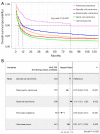Development and validation of a prognostic predictive model of pulmonary spindle cell carcinoma from the surveillance, epidemiology and end results database
- PMID: 36093529
- PMCID: PMC9459631
- DOI: 10.21037/tcr-22-427
Development and validation of a prognostic predictive model of pulmonary spindle cell carcinoma from the surveillance, epidemiology and end results database
Abstract
Background: Pulmonary spindle cell carcinoma (PSCC) is a rare type of non-small cell lung cancer (NSCLC). The prognostic influent factors and therapeutic methods of PSCC are unclear, for there are only some case reports or small samples' analysis. This study aims to find prognosis related factors of PSCC, develop and validate a nomogram to predict their survival probability.
Methods: The Surveillance, Epidemiology, and End Results (SEER) 18 Registries database (2000-2018) was searched to study PSCC. According to diagnosed time, data was divided into primary cohort (2000-2015) and validation cohort (2016-2018), both followed until December 31 2018. Chosen by Least Absolute Shrinkage and Selection Operator (LASSO) regression, age, sex, stage, surgery, chemotherapy, N, size and history of malignancy were taken out as predictive variables. The primary cohort was used to develop a nomogram to predict 1-, 3- and 5-year overall survival (OS) probability, and be validated by the validation cohort using concordance index (C-index) and calibration curves. Both cohorts were used to conduct a Cox regression to find the influential factors on OS of PSCC.
Results: The nomogram shows a good concordance and discrimination on the prediction of OS, both internal (n=457 and C-index is 0.79) and external validation (n=100 and C-index is 0.76). The median survival time of PSCC is 4 months, with 20.1% OS possibility in 5 years. Multivariate analysis identified patients of older age [hazard ratio (HR), 1.02; 95% confidence interval (CI): 1.01-1.04], larger size of neoplasm (HR, 1.01; 95% CI: 1.01-1.01), M1 (HR, 2.96; 95% CI: 2.17-4.04), N2 (HR, 2.55; 95% CI: 1.81-3.59) or N3 (HR, 2.99; 95% CI: 1.58-5.66), regional stages (HR, 2.11; 95% CI: 1.29-3.44) and distant stages (HR, 6.17; 95% CI: 3.83-9.94) had a lower OS possibility, while surgery (HR, 0.39; 95% CI: 0.28-0.53) and history of malignancy (HR, 0.68; 95% CI: 0.48-0.98) was protective factors for PSCC. PSCC survived longer with surgery performed instead of chemotherapy or radiotherapy.
Conclusions: Patients of PSCC have a poor prognosis, and using the nomogram developed by this study can predict their 1-, 3- and 5-year OS probability. Surgery is a better choice for PSCC and more studies are necessary to find potential treatment like targeted therapy, programmed death-1 (PD-1) and programmed death ligand 1 (PD-L1).
Keywords: Pulmonary spindle cell carcinoma (PSCC); Surveillance, Epidemiology, and End Results (SEER); prognosis; pulmonary sarcomatoid carcinoma (PSC).
2022 Translational Cancer Research. All rights reserved.
Conflict of interest statement
Conflicts of Interest: All authors have completed the ICMJE uniform disclosure form (available at https://tcr.amegroups.com/article/view/10.21037/tcr-22-427/coif). The authors have no conflicts of interest to declare.
Figures







Similar articles
-
Clinicopathological characteristics and prognosis of pulmonary spindle cell carcinoma (PSCC): a population-based retrospective study.Ann Palliat Med. 2021 Apr;10(4):3793-3803. doi: 10.21037/apm-20-1841. Epub 2021 Mar 8. Ann Palliat Med. 2021. PMID: 33691442
-
Establishment of a Competing Risk Nomogram in Patients with Pulmonary Sarcomatoid Carcinoma.Technol Cancer Res Treat. 2022 Jan-Dec;21:15330338211068960. doi: 10.1177/15330338211068960. Technol Cancer Res Treat. 2022. PMID: 35179409 Free PMC article.
-
Development and Validation of a Nomogram-Based Prognostic Evaluation Model for Sarcomatoid Hepatocellular Carcinoma.Adv Ther. 2020 Jul;37(7):3185-3205. doi: 10.1007/s12325-020-01357-3. Epub 2020 May 20. Adv Ther. 2020. PMID: 32436026
-
A prognostic nomogram based on least absolute shrinkage and selection operator Cox regression in patients with pulmonary large-cell neuroendocrine carcinoma.Transl Cancer Res. 2024 Feb 29;13(2):916-934. doi: 10.21037/tcr-23-1061. Epub 2024 Jan 24. Transl Cancer Res. 2024. PMID: 38482439 Free PMC article.
-
Nomogram prediction of overall survival based on log odds of positive lymph nodes for patients with penile squamous cell carcinoma.Cancer Med. 2020 Aug;9(15):5425-5435. doi: 10.1002/cam4.3232. Epub 2020 Jun 10. Cancer Med. 2020. PMID: 32519819 Free PMC article.
Cited by
-
Spindle cell carcinoma of the lung with myogenic differentiation in a young female patient: a rare case report.Ann Med Surg (Lond). 2025 Apr 22;87(7):4532-4535. doi: 10.1097/MS9.0000000000003308. eCollection 2025 Jul. Ann Med Surg (Lond). 2025. PMID: 40851986 Free PMC article.
References
LinkOut - more resources
Full Text Sources
Research Materials
